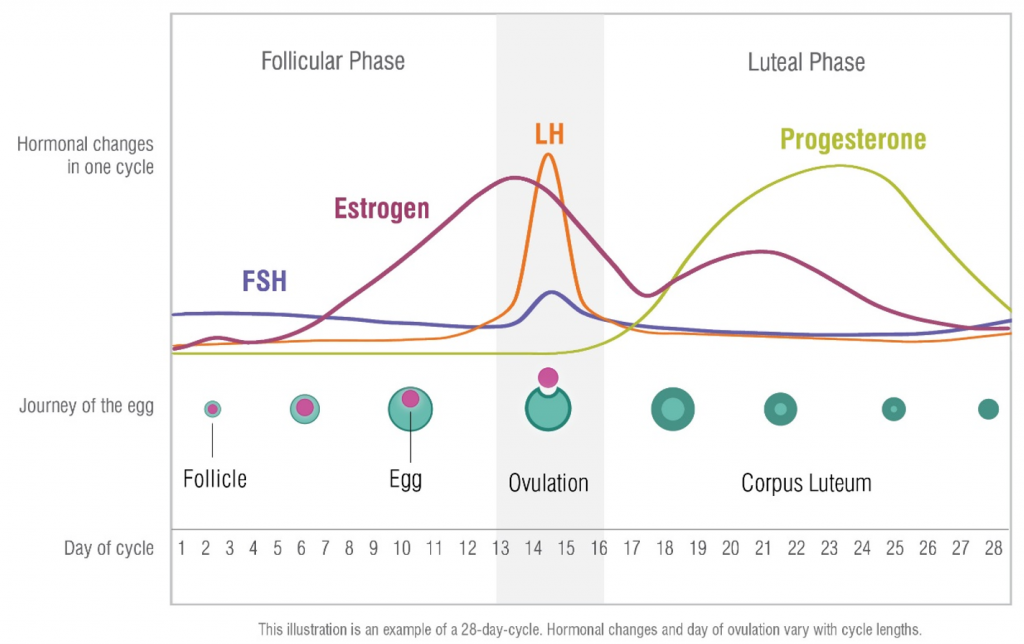Did you know that performance advice for athletes are mostly based on studies done on young white males, but are generalized to all other populations? How should those of us, from demographics who are not typically studied, approach the mainstream training advice? .
So I’m training for a marathon this year. It’s been a while since I was on a training regimen, and I had coaches back then to push and help me do my best. These days I’m on my own to figure out my workouts, fueling, hydration, etc. There’s a lot of new info!
Below are notes from the various emerging research on gender differences and performance. At the end of this post I reference resource persons and podcasts where I learned these.
Note this is specific to female athletes and how we can leverage the phases of our menstrual cycle to maximize performance potential. There’s also new research for those across the gender spectrum, and other demographics.
Leveraging the Menstrual Cycle for Training Effects
This visual below depicts the typical cycle of 28 days (this length varies by individual). Day 1 indicates the first day of bleeding, and this onset occurs due to the drop in oestrogen and progesterone.

In the week before bleeding starts:
- It’s harder to access carbs to fuel high intensity workouts.
- Instead of focusing on intensity, focus on skills-based, de-loading, technique and functional movement, to lower our cardio stress, e.g., work on form when doing reps, when running, etc.
- Keeping our training stress down helps reduce cortisol, the hormone involved in storing body fat.
During the period (Day 1 of the menstrual cycle is the first day of bleeding):
- Mineral needs go up, e.g., Mg (that’s why there’s chocolate cravings) and Zinc
- More carbs are needed to do higher intensity work, because our energy needs grow by ~150cal; the body is building uterine lining.
- Kispeptin (co-transport mechanism) is sensitive to low carb situations, so its activity falls if our diet is low on carbs, which puts the body in starvation mode and leads to increased storage of body fat.
- Endocrine function is also thrown off if the body doesn’t get enough carbs. It is different for men because they have a different endocrine environment.
In this first half of the cycle, or low hormone phase (Day 1-14):
- This is when women can work to improve strength, the overall top end power, our aerobic or anaerobic capacity.
- The body uses carbs well – it can access and store carbs, so we can decrease carb intake in this phase.
- As estrogen and progesterone start to rise – first estrogen during Ovulation – our carb intake needs to increase. Our protein intake needs to increase also, to counter the catabolic effect of progesterone (muscle tissue breakdown).
- Aim for high intensity workouts during this low hormone phase, e.g., fast repeats, hills, plyometrics, heavy lifting with low reps.
Around Ovulation the ligaments loosen (part of preparation for possible pregnancy) which brings increased risk for ligament years, like ACL tears.
In the high hormone phase the body can’t access and store carbs as well, so carb intake should increase, e.g., foods that are low on the food chain, like greens.
- Hydration should increase during this high hormone phase; it’s not a good idea to rely on thirst so in long duration activity like long runs, drink on a schedule.
- Training should be lower intensity with more focus on functional fitness, technique, running skills, in high hormone phase (e.g., the week before period).
This strategy is better for lean mass and muscle development than doing strength training 3-4x/wk strength:
- Low intensity work (form and function) towards the later half of the cycle, or the high hormone phase
- High intensity workouts in the first half of the cycle, or the low hormone phase
These quick summaries are for my personal reference; there is so much to learn. Anyone who has a daughter or who coaches or mentors young girls and women can help them stick to their sports, or optimize their athletic potential(!), by just knowing and working with this menstrual cycle. It’s a game changer that helps girls stay active (rather than letting them quit because of a lack of understanding about all the changes happening at puberty and by cycle). I’m grateful for the scientists who are spearheading research studies around this important topic. Only a few of them are listed below, but I’ll add to it as I learn of them.
Researchers Studying Gender Differences and Exercise Science
Researchers who are active online on their blog, on twitter or instagram:
- Kirsty Sale – Professor of Female Exercise Physiology
- Laura Forrest – Lecturer in Sport and Exercise Physiology; Research interests in applied physiology, female athlete and health
- Dr Brianna Larsen Lecturer (Sport & Exercise Science) @USQSportSci @usqedu Heat physiology | Female athletes | Exercise performance
- Kate Mahony Head of Performance Health @NSWIS | Sports Physio | Churchill Fellow 2018
- Alex Macznik #researcher | #sportsinjuryriskreduction | #femaleathlete |
- Stacy T. Sims – Female athlete performance expert
- Nina Stockenfeld, Yale – Research on progesterone, estrogen and fluid balance in women and men
Podcasts I found really helpful are below. For some of them, I had to listen a few times!
- FTP #35: Kelly McNulty & Kirsty Elliott-Sale – The Female cyclist series: Menstrual cycle and endurance exercise performance
- Does female physiology makes them better at ultra-endurance sports?
- Part I: Female Physiology and Sports (vs Men) by Beatriz Fernandes [This is a guest post by Beatriz Fernandes. Beatriz received her BS in Exercise Science, MS in Management and is currently participating in the Athletic Lab Internship Program. Beatriz has experience coaching at a variety of levels in the US and over in Europe and holds certifications with US Soccer.]
- Triathlon training and nutrition considerations for female athletes Feb 2018 – Stacy Sims, PhD
- Leanna Ward Nutrition Dec 2019 – Optimizing nutrition and training Part 1 and 2
- Wild AI podcast Jan 2021– Stacy Sims and Julie Foucher
